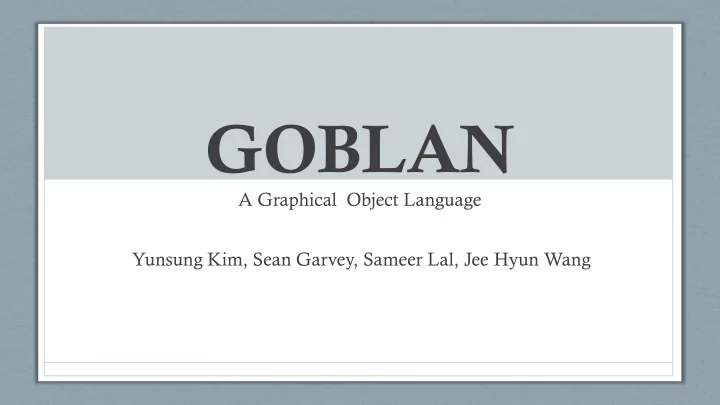

GOBLAN A Graphical Object Language Yunsung Kim, Sean Garvey, Sameer Lal, Jee Hyun Wang
Table of Contents • Graph Programming in Conventional Languages • Graph Programming in GOBLAN • What is “Message Passing?” • Strength of GOBLAN • Structure of GOBLAN • Demo
Graph Programming in Conventional Languages • Conventional Languages implementation of graph programming • Can be tedious, time consuming • Usually try to manipulate the graph as a whole, by using lists and arrays, and many loops.
Graph Programming in GOBLAN • Domain specific language for constructing and manipulating complex structured graphs • Introduces a new paradigm of graph programming • Message Passing • Enables the communication between individual nodes
Message Passing • Algorithms consists of two parts 1) Communicating data between nodes through messages 2) Processing messages to update current node data Many graph algorithms fall into the paradigm of message passing • msg node_1 node_2
Message Passing Tree search 1 Q: Where is ? 2 3 4 5 6 8 7 9
Message Passing Tree search 1 Query Q: Where is ? Query Query 2 3 1. Receive message 4 5 6 8 7 9
Message Passing Tree search 1 Q: Where is ? “Do I have ?” 2 3 2. Process message Query 4 5 6 8 7 9
Message Passing Tree search 1 Q: Where is ? “I'm 3 and I have !” 2 3 3. Pass message Query 4 5 6 8 7 9
Message Passing 1. 1→3 Tree search 1 Q: Where is ? 2 3 3. Pass message Query Query Query Query Query 4 5 6 8 7 Query 9
Message Passing 1. 1→3 Tree search 1 Q: Where is ? 2 3 1. Receive message “I'm 3 and I have !” 4 5 6 8 7 Query 9
Message Passing 1. 1→3 Tree search 1 Q: Where is ? 2 3 2. Process message 1. 3→7 4 5 6 8 7 Query 9
Message Passing 1. 1→3 2. 1→3→7 Tree search 1 Q: Where is ? “3→7” 2 3 3. Pass message 1. 3→7 4 5 6 8 7 Query 9
Strength of GOBLAN 1. Intuitive node declaration 2. Object function: run { node } ( arg1, arg2, …. ) 3. Message passing: pass pkt -> chld 4. Graph construction: new graph(node:A )[|…|] 5. Compiles to LLVM
Strength of GOBLAN 1. Intuitive node declaration node:NodeType { data { /* data specification */ } edge { /* edge attribute specification */ } pack { /* message attribute specification */ } type do (type arg1, type arg2, ...) { /* asynchronous function definition (Can be called anywhere in the program) */ } catch { /* synchronous function definition (Invoked upon receiving a message) */ } }
Strength of GOBLAN 2. Object function: run { node } ( arg1, arg2, …. ) • Asynchronous object function Allows simple invocation of graph algorithms • Invoked anywhere in the program •
Strength of GOBLAN 3. Message passing: pass pkt -> chld • Simple keyword : chld | prnt |prnt_chld | chld_prnt High level encapsulation of intricate recursion •
Strength of GOBLAN 4. Graph construction: new graph(node:A )[|…| ] • Interconnecting nodes through statements that are easy to understand
Strength of GOBLAN 5. Compiles to LLVM
Structure of GOBLAN • How graphs are represented N 1 … chld prnt … ID edge N2 N1 edge edge N 2 ID chld … prnt …
Structure of GOBLAN (compiling) Lexer Parser Semantics AST List.bc List.c clang Code LLVM-LINK executable SAST Generation
DEMO • Dijkstra's algorithm • Tree Search
DEMO • Dijkstra's algorithm
DEMO • Tree Search Id: 0 0 Data: 0 Id: 2 Id: 1 Id: 3 1 2 3 Data: 2 Data: 1 Data: 3 10 8 4 5 6 7 9 Id: 6 Id: 10 Id: 4 Id: 7 Id: 8 Id: 5 Id: 9 Data: 2 Data: 1 Data: 0 Data: 3 Data: 0 Data: 1 Data: 1
Recommend
More recommend